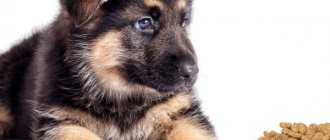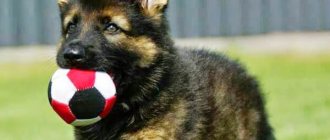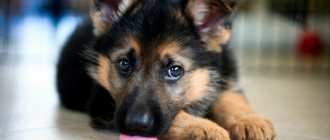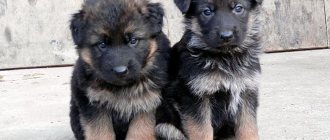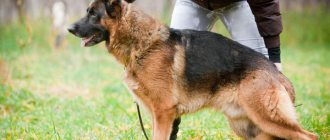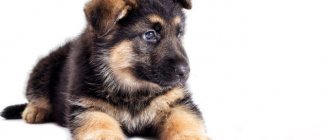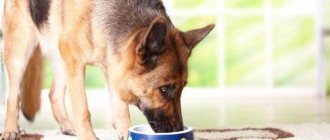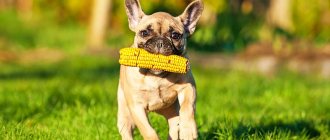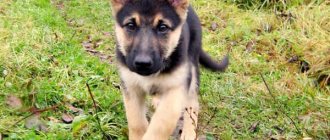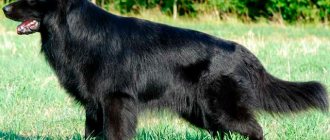The German Shepherd is a breed of dog that appeared in Southern Germany through the crossing of several breeds.
Representatives of this “family” are distinguished by intelligence, loyalty and receptivity to training.
Basically, breeders take such dogs for protection purposes, an exhibition career or as a “family dog”.
In this article we will talk about German Shepherd puppies aged 4 months - how to care for them, what to feed them and how to train them.
External changes of the puppy (photo)
At 4 months the puppy is almost an adult. The alignment (formation) of the ears is striking. They will finally get up by six months.
Minor changes in color are observed (in some places the fur darkens, in others, on the contrary, it acquires lighter shades), because the baby's undercoat begins to change into adult hair
Teeth begin to change and will completely change by 7 months of age.
Joints and ligaments are actively developing, which entails active growth both in height and in width.
IMPORTANT!
At the age of 4 months, it is necessary to make it clear to the puppy who is the leader in the family (if the dog was taken for the purpose of creating a “family dog”) or who has become its owner (if the dog is taken for a show career).
The dog itself will begin to “test the waters” - it will begin to try different styles of behavior with each family member until it finds one that suits the person.
The photo below shows what a German Shepherd puppy looks like at 4 months.
Teach your puppy the “Sit” command for endurance
At the first stage, command the puppy, who is on a leash, “Sit.” Take two steps to the side. Movement - at a slow pace, facing the pet. Give the command “Sit” again. When five seconds have passed, return to the puppy. Say: "Okay!" and pet him.
In the second stage, increase the distance so that it becomes equal to the length of the entire leash. Exposure time - 15-30 seconds. At the third stage, returning to the puppy, walk around behind him in a circle so that you are again in the “Next” position.
How does character change?
At the age of 4 months, the puppy tries to establish a hierarchy for itself in the family. It is necessary to show who should be obeyed and who should be protected. It is important that the puppy understands that all members of his family are more important than him.
Due to such a complex stage of psychological development, it is quite difficult to talk about the puppy’s character. Aggression abruptly gives way to playfulness and affection, and they, in turn, can give way to timidity.
Mostly, somewhat apathetic behavior is noticed, especially when the puppy is tired.
Also, at this age, dogs lose attention, so even familiar commands may not be followed.
What complex exercises should you use?
Let the puppy stand next to you. Alternately give the commands “Stand”, “Lie down”, “Sit”, using different sequences.
Does your puppy refuse to sit on command? Repeat the command (the intonation is threatening), and press on the dog’s lower back with one hand. With your other hand, grab the leash just behind the collar and pull back. Then you can reward the puppy.
Does the puppy not accept the command “Lie down”? Repeat it with a threatening intonation and put the puppy down. To do this, pull the dog's front legs forward with one hand, and with the other hand press on the withers. Then reward the puppy.
Puppy won't get up when commanded "Stay"? Give the command again, using a threatening intonation. Hold the dog's collar with one hand and lift it with the other, supporting it under the belly.
Height and weight
The growth parameters at the withers for babies are approximately 40-42 cm for females and 45-47 for males.
At this age, active gain of muscle mass begins. Weight should be about 17-20 kg (15 is the minimum for good development).
The third and fourth weeks - the beginning of socialization
In the third week of life, puppies already see well and are already beginning to hear. They are still dependent on their mother and feed only on her milk, but they are already starting to play with their brothers and sisters, trying to lick and bite different objects.
During this period, their baby teeth appear. Puppies test their severity on their siblings, biting each other as they play.
This is a natural behavior through which they learn to play with other animals without harming them.
At this stage of development, the puppy's contact with people becomes very important. The dog needs to be petted and picked up. This must be done carefully and make sure that the kids have only pleasant emotions.
If a puppy is separated from his dam and siblings at this stage of his life, he may become overly aggressive in the future and have difficulty interacting with other animals. In turn, the lack of human contact or the presence of negative stimuli that cause anxiety and pain can make an adult dog fearful or not receptive to affection.
Which food to choose?
Proper nutrition is necessary not only for humans. In the first year of life, a balanced diet forms the basis for a dog’s development, so it is important to correctly create a menu and think through the diet.
At 4 months, the German Shepherd can be switched to three meals a day.
There are 2 feeding options:
- traditional (homemade food);
- canned food and dry food.
At such a tender age, it is recommended to feed the dog homemade food, because... this promotes the development and strengthening of the gastrointestinal tract. Subsequently, even if you plan to switch your dog to dry food, there will be no problems.
Dry food can also be given to your puppy. This is a more convenient alternative to traditional nutrition, because... easy to use.
NOTE!
Do not forget that when choosing dry food as a permanent diet, you must use only proven, high-quality food. It’s good if the puppy eats super-premium food, because it contains the required percentage of meat content.
Rules of conduct for a puppy
The puppy must know that he should not leave the confines of the yard and home without your permission. In the same way, he must learn that he can leave the house and enter it only with your consent. To teach these skills, the puppy is first trained to wear a choke collar.
The first step is to approach the boundary you set with your puppy on a short leash. You are slowly crossing the border. If the puppy tries to follow you, say “Ugh” in a threatening manner and yank the leash. Did the puppy obey? Praise him. Is the situation reversed? Repeat the command and jerk.
To get the puppy to cross the boundary (when you go for a walk), command “Near” and reward the puppy for obedience.
At the second stage, complicate the exercise: place a toy or treat abroad. The puppy must remain within the boundaries and not react to these objects. Is the dog trying to cross boundaries? Stop her immediately!
Basic feeding rules
First, you need to decide on a permanent feeding place so that the puppy does not drag his food around the house. Then choose a specific meal time and stick to it.
The volume of food per day should be 1-1.25 liters.
The bowl with a portion of food should be set out for about 15 minutes and then removed so that the puppy gets used to the time allotted for feeding and does not leave food “for later.”
Do not give hot or cold food. Pet food should be at room temperature.
Natural food
The puppy's menu should be varied and include meat, vegetables, fish, cereals and milk.
Approximate daily menu for a puppy:
- 400 grams of meat (preferably turkey or beef, as they will not cause an allergic reaction);
- 150-200 grams of cereals (buckwheat or rolled oats are ideal);
- egg;
- 200 grams of cottage cheese (or any other dairy food);
- 200 grams of vegetables (by the way, carrots help strengthen bones and improve coat);
- 30 grams of sunflower oil.
How often to feed and how much to give?
All this deliciousness must be divided into several servings (4 is the maximum). Accordingly, one serving will be 250–300 grams.
But every breeder needs to monitor the puppy’s behavior after eating to adjust the portion size. If the dog actively licks the empty bowl, shows restlessness and whines, then the portion size should be increased, and if the dog does not finish eating, it should be reduced.
Harmful products
Harmful products include:
- potato;
- corn;
- fried foods;
- bread and pastries;
- pasta;
- legumes;
- pork (due to the high fat content of this meat);
- pickled and salted vegetables.
This is something that should absolutely not be given to a puppy.
Dry food
As already mentioned, for puppies it is necessary to choose super-premium food. Yes, they are more expensive than other classes of food, but you cannot save on your pet’s health.
Popular manufacturers of puppy food are:
- Dukes Farm;
- Bosch;
- Eukanuba;
- Arden Grange;
You can also use PURINA products, but with caution, because... This food contains a large amount of dry chicken meat, which can cause an allergic reaction.
Decisions regarding food should be made based on the puppy's reaction. If allergies or problems with stool occur, the condition of the dog’s coat, mucous membranes or general condition has worsened, then you should refuse this food.
It will not be superfluous to study reviews on the Internet regarding a particular manufacturer.
IMPORTANT!
You can give dry food as often as natural food (3-4 times a day), but reduce the portions in accordance with the recommendations indicated on the package.
Vitamins
No matter how balanced the puppy’s diet is, a sufficient amount of vitamins does not enter the dog’s body. Therefore, it is necessary to include vitamin supplements in your nutrition plan.
Puppies need calcium. Especially at the age of 4 months, when the formation and development of the skeleton and ligaments occurs.
The following can be used as bait:
- phosphorus;
- calcium gluconate;
- glucosamine
Calcium is difficult to absorb in the body of a German Shepherd, so it must be given with fermented milk products.
Vitamin A is found in apples and carrots. If a puppy does not receive enough of this vitamin, then its immunity suffers.
Vitamin B. This includes vitamins B1, B2, B3, B6, B9 and B12. Responsible for metabolism. Contained in liver, dairy products and yeast. If there is a deficiency, the dog’s metabolism is disrupted and the condition of the coat worsens.
Vitamin C is responsible for the absorption of calcium and the normal condition of connective tissues. Contained in tomatoes, cabbage and liver.
Vitamin D. Contained in fermented milk products. With its deficiency, rickets can develop.
Vitamin E is found in oils. Responsible mainly for the hormonal background of the dog. Therefore, a sufficient amount of it is more necessary for bitches, because if it is deficient, hormonal imbalance may occur, leading to stillbirth, infertility, and heart and muscle problems.
Vitamin K is responsible for blood clotting and is found in huge quantities in nettles and lettuce.
Regarding vitamin complexes, you can indicate “Trivit” (oil drops, add 3-5 drops per day to food), brewer’s yeast. Add seaweed and seaweed to your dog’s diet.
NOTE!
Garlic flour is harmful to parasites (for example, worms). Don't give too often or too much. A small portion once every 4-5 weeks is enough.
There are also a huge number of vitamin complexes for puppies that can be purchased at veterinary pharmacies.
Puppy from 4 to 8 months: what is he like and what does he need?
Conventionally, a dog is considered “adult” at 1 year, and large puppies at 2 or even 2.5 years. Of course, the process of growing up does not end suddenly, with the wave of a magic wand, and each pet has its own path. However, by 8 months of life, a young dog has already overcome the most rapid stages of growth and development, mastered basic commands and is fully socialized. Let's talk in more detail about these achievements.
What happens to a puppy between 4 and 8 months?
- Changing baby teeth to permanent ones
The puppy's teeth continue to change. On average, a dog has a full set of “adult” teeth by 8-9 months. All pets experience the change of teeth differently. Some don’t seem to notice it at all, while others chew on everything and even refuse to eat because of discomfort in their gums.
How to help?
— Regularly monitor the condition of the oral cavity. Consult a doctor if your teeth grow in two rows or your gums are inflamed. Buy a variety of dental toys and treats for your dog: they will reduce discomfort and help cope with stress.
— Properly care for your dog’s teeth. Think about what will be more convenient for you: brushing your pet’s teeth with a special brush and toothpaste, using dental treats and toys, nutritional supplements, or both. Now your pet has adult teeth and maintaining their health is very important. Check your oral health regularly. Plaque and tartar must be promptly removed by a veterinarian, otherwise the dog’s dentistry will become a significant part of your worries and material costs.
Don't scold your dog if it chews your shoe. She’s really not out of malice: her gums itch and she’s trying to cope with this condition as best she can. Instead of punishment, buy her a new dental toy!
- Mastering basic commands and socialization
By 8 months, with the right approach, the puppy will know all the basic commands and will be able to boast of exemplary behavior anywhere: at home, in transport, on the playground and even at the veterinarian’s appointment.
What to do?
Repeat basic commands: you can’t, ugh, come to me, place, sit, lie down, stand, next to you, fetch, etc. Move on to practicing more complex commands: “Voice”, “Crawl”, “Wait”, to commands with gestures, master clicker. Continue to explore the world around you and conquer new heights!
- First molt
The puppy's downy baby coat begins to change at about 6-7 months. How much a dog sheds depends on its breed and individual characteristics. In some dogs, shedding occurs almost unnoticed, while others “cover” everything around with hair.
If your dog itches a lot, and bald patches, wounds, and areas of inflammation appear on the skin, contact your veterinarian immediately.
How to help?
— Regularly monitor the condition of the skin and coat. If alarming symptoms appear, contact your veterinarian. It is important not to confuse shedding with a dermatological disease.
— Choose proper care for your dog: shampoo, conditioner and other skin and coat care products. Now your pet has adult fur, and its health and beauty must be monitored closely.
- Puberty
5-6 months is also the beginning of puberty. Any day now, the female may begin her first heat, and the males begin to identify themselves as adults, become restless and vigorously sort out relationships with other dogs on the site.
Don't worry if your pet has not yet started to come into heat at 6 months: this may happen a little later, by one year or even later.
What to do?
— Support your pet, even if he is trying to fight with the neighbor’s terrier for the third time that day.
— Enlist the support of a dog handler or animal psychologist if the dog does not listen to you and behaves aggressively.
- Don't rush things. The first heat is not the time for the first mating. The dog's reproductive system and body continue to develop. It is better not to plan the first mating until the dog is at least 1.5 years old.
— Avoid places where dogs congregate and postpone a visit to the veterinary clinic or grooming salon until the dog is no longer in heat.
- Walk your dog only on a leash, choose quiet places for walks. Be careful: dogs are prone to running away during puberty!
— If the dog behaves restlessly, discuss taking sedatives with your veterinarian.
- First conflicts
At about 7 months, a dog may begin to conflict with its four-legged friends. Just yesterday they were playing ball together, and today they are acting like enemies! Don't worry: this is temporary and normal. Dogs begin puberty. They establish their place in the pack, look for their place in the sun, and “present” themselves anew. From now on, other dogs will perceive your pet not as a puppy, but as an adult dog.
What to do?
— Reduce stress, distract the dog, direct energy in the right direction.
— Friendly, but demanding work on obedience.
- Behave correctly when meeting other dogs. Do not aggravate the situation and do not contribute to conflicts.
- Puppies reach the size of adult dogs
But not all, but only puppies of small and medium breeds. If a Yorkie puppy at 8 months looks like an adult representative of its breed, then the Great Dane is still growing.
- Active and long walks
By 8 months, a dog can tolerate 5-hour intervals between walks, and he needs to be rewarded for this! Leave the gadgets on the shelf and please your pet with active games in the fresh air. Moreover, the dog’s musculoskeletal system is already strong enough, and it can already jump over barriers to its heart’s content!
What to do?
— Purchase a variety of toys for fetching and joint games.
— Find a good playground for dogs with an obstacle course.
— If the dog’s capabilities allow, you can master agility!
What else do you need to remember?
- Do not forget about preventive examinations with a veterinarian, regularly vaccinate and treat against parasites.
- Make sure your dog is eating well and that the food you choose is suitable for him. Follow feeding rules. Combine dry and wet food, but do not mix ready-made food with refrigerated food.
- Give your dog special balanced treats rather than your favorite delicacies.
- Always keep at hand the contacts of a veterinary specialist and the nearest veterinary clinics, including 24-hour ones.
Checklist: what does a dog need?
And finally, a checklist of essential accessories for a teenage puppy. Check if you have all of this.
- Two bowls: one for water, one for food.
- Bed.
- Cage-aviary.
- Container for transportation (carrying).
- Collar with address tag, leash (harness, tape measure), muzzle.
- Skin and coat care products: shampoo, conditioner, detangling spray.
- Tools and products for grooming: nail clipper, combing tool (brush, furminator, etc.), lotion and wipes for cleaning eyes and ears, clipper or scissors (if necessary), etc.
- Complete first aid kit.
- Clothes and shoes - if necessary.
- A variety of toys for joint and independent play.
Have you checked? Is everything in place? Then you can continue to be the best host in the world!
Happy growing up to your pet!
Care requirements
At 3-4 months, puppies begin to actively grow - their legs lengthen, their torso and muscles grow.
Veterinarians say that the main cause of disease in dogs is the lack of hygiene procedures. Therefore, they are extremely important for a puppy.
All mucous membranes must be washed. Eyes and ears - clean.
You should always monitor your pet's eyes. If increased tearing begins, or the mucous membranes turn red, or the dog becomes restless and scratches its eyes, they should be washed with chamomile infusion using a cotton pad.
You need to brush your teeth once a month. You can purchase special tooth powder at a veterinary clinic or use bones containing fluoride. They perfectly remove plaque and massage your pet’s jaw.
Particular attention should be paid to the ears. At this age, they have not yet risen, so a large amount of dirt accumulates in the ears. They should be washed once a month using chlorhexidine and a cotton pad. It will also be appropriate to examine the ears for redness and inflammation.
You shouldn't bathe your dog often. Optimally – 3-4 times a year.
Master the skills of transportation in vehicles with your puppy
This skill can be learned by a puppy who is not afraid of passing vehicles or crowds of people. The puppy must get used to the harness, leash, muzzle, and collar in advance. He must be able to carry out the commands “Near”, “Lie down”, “Come to me”, “Sit”, must be able to overcome stairs and small obstacles.
In a trolleybus, tram, bus or train, a puppy on a short leash and a collar. In the cabin or carriage, do not lose sight of the puppy, keep him close to you. Allow your dog to lie down as long as it does not interfere with other passengers.
If the puppy has to travel by car, take a bedding for him. Inside the car, the puppy must demonstrate calmness. If your pet's behavior is not ideal, give the “Place” command. If necessary, use a leash to restrain the animal. First of all, get familiar with getting in and out of the car with your puppy. Then you can take short trips, gradually increasing their duration.
How to train?
The goal of training a 4-month-old puppy is to ensure strict compliance with commands. Moreover, commands can be given by voice and gestures.
Outdoor training depends on the weather. You cannot exercise for a long time if the temperature is below 10 degrees and above 15. This is dangerous for puppies, because... can cause a cold and more dire consequences.
At this age, dogs are still afraid of sudden movements. Therefore, the breeder should turn training into a game in order to reduce the risk of fright.
The dog does not understand every word of its owner and is more focused on the intonation of the voice. Taking into account the timidity of puppies, try to make the commands sound confident, but not threatening.
The first thing a puppy must learn is its name. Repeat it at every opportunity, when addressing the dog, look into its eyes, because visual contact is very important. The dog must understand that it is he who is being addressed.
The second important command is “Get in place!” Of course, to do this you need to show the puppy where exactly “his place” is. You won’t be able to learn a command in one day, but it won’t take much time with daily training.
“Come to me” is the third most important command. Teaching a puppy this order is quite simple: call him with a command + make movements with your hands, which the puppy perceives as an invitation to come up.
“Sit”, “stay” and “lie down” are 3 commands that a puppy can learn at 4 months. You shouldn’t put a big emphasis on it if it doesn’t work out, but you shouldn’t quit either. With age, you can achieve precise execution of these and many other commands.
IMPORTANT!
When training a four-month-old puppy, it is important to remember about distraction (mentioned above) and devote a maximum of 10 minutes to each command!
By approaching the issue of education correctly, any dog can be turned into an excellent companion. The “Germans”, due to their developed intelligence and loyalty, are simply excellent in this role. Therefore, everything depends on the owner.
How to teach a puppy to the “Come to me” command?
Be in the center of the puppy's attention all the time with the help of treats, a favorite toy, and an exciting game. Walk him along unfamiliar routes, where the puppy will not behave so confidently and, accordingly, will not lose sight of you.
Training a puppy and its adoption of good behavior patterns should begin before he begins his own upbringing.
Your growing friend has already learned to clearly distinguish between friends and strangers. Moreover, he often shows a distrustful attitude towards strangers. This behavior is highly desirable and should be encouraged. But it is necessary to stop the dog from showing too much irritation when strangers appear, since the dog must be adapted to life in society. You can learn about the behavioral characteristics and nuances of raising a dog depending on the breed here.
It is worth noting that until recently, when an adult dog approached, your puppy assumed a pose of submission, and with his peers started a fun romp that did not turn into a showdown. But now everything is different. The growing puppy begins to show the first signs of behavior caused by the instinct of territoriality. He already clearly distinguishes between friends and strangers, making attempts to drive the latter away from his familiar territory, which inevitably leads to conflict situations.
This dog behavior should not be encouraged, much less provoked. Otherwise, feeling her strength, she will rush at all unfamiliar dogs. And this greatly overshadows the joy of walking together.
You should also train your dog to be in your field of vision. While walking, your pet may become very interested in new smells and simply not hear your commands. Therefore, before you call, attract his attention with a sharp sound (a whistle, a snowball or stick thrown near him, etc.). For following the command, be sure to give the puppy a dog treat.
Porridge and baked goods
Cereals are a source of easily digestible carbohydrates by the body. In addition, the shepherd dog eats porridge with pleasure. For cooking, use a minimum of salt, vegetable oil, broths and vegetables.
Suitable cereals:
- rice;
- buckwheat;
- Hercules;
- semolina.
It is better to buy buckwheat for a puppy unfried. Cooked rice should be crumbly and free of moisture. Rice water can be offered to your puppy for stomach upset.
The volume of porridge in the daily diet should not exceed 30%.
Semolina porridge is easily digestible, but contains a minimum of nutrients. Its presence in the puppy’s diet is not necessary. Can be used as a tonic for stomach disorders. Contraindicated in dogs prone to obesity.
Pasta, bread and buns made from white flour are not good for a shepherd. It is not recommended to give them to a puppy. Germans enjoy eating crackers. As a delicacy, it is permissible to make rye, whole grain, dried rice slices without yeast.
Harmful products
When choosing food for a shepherd, you cannot rely on human habits. The dog should absolutely not be fed from the owner's table. Not all foods that are appetizing to a puppy are actually suitable for him to eat.
Harmful and poorly digestible foods:
- corn;
- potato;
- legumes;
- spicy;
- spicy;
- roast;
- pickled and canned;
- pork and other fatty meats;
- pasta;
- White bread;
- semi-finished products for people.
The possibility of individual intolerance by the body to any permitted product cannot be discounted. The owner should focus primarily on the pet’s reaction and its health.
Vegetables and fruits
Vegetables for a growing body are an accessible source of fiber, carbohydrates, vitamins and minerals. With their help, they provide variety and richness in the puppy’s nutrition. Can be given raw, pureed, or boiled and chopped. Fruits are high in vitamins and are a healthy addition to a natural diet.
The puppy should receive at least 150 grams of vegetables per day
Vegetables suitable for a puppy:
- carrot;
- pumpkin;
- zucchini;
- asparagus;
- cucumbers;
- beet;
- nori seaweed and kelp.
Apples and berries are good for a four-month-old shepherd dog. Many kids like raspberries and currants. It is acceptable to add greens to food.

